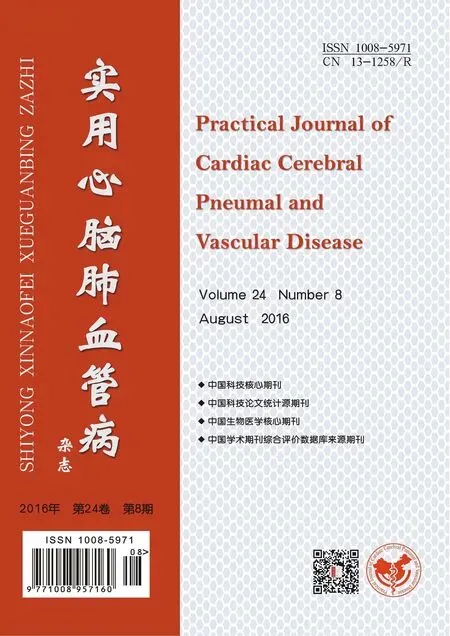高频振荡通气与常频通气治疗新生儿呼吸衰竭临床效果的对比研究
刘春枝,梅 花
·疗效比较研究·
高频振荡通气与常频通气治疗新生儿呼吸衰竭临床效果的对比研究
刘春枝,梅 花
目的比较高频振荡通气与常频通气治疗新生儿呼吸衰竭的临床效果。方法选取2013年内蒙古医科大学附属医院收治的呼吸衰竭患儿100例,随机分为高频振荡通气组(A组)和常频通气组(B组),每组50例。两组患儿入院后予以对症支持治疗,A组患儿行高频振荡通气,B组患儿行常频通气。比较两组患儿机械通气前、机械通气6 h后心率、平均动脉压、血气分析指标〔动脉血氧分压(PaO2)、动脉血二氧化碳分压(PaCO2)、动脉血氧饱和度(SaO2)、吸入氧浓度(FiO2)〕及机械通气时间、住院时间、院内死亡情况。结果机械通气前、机械通气6 h后两组患儿心率、平均动脉压比较,差异均无统计学意义(P>0.05);两组患儿机械通气6 h后心率低于机械通气前(P<0.05)。机械通气前两组患儿PaO2、PaCO2、SaO2、FiO2比较,差异无统计学意义(P>0.05);机械通气6 h后A组患儿PaO2、SaO2高于B组,PaCO2、FiO2低于B组(P<0.05)。两组患儿机械通气6 h后PaO2、SaO2高于机械通气前,PaCO2、FiO2低于机械通气前(P<0.05)。A组患儿机械通气时间、住院时间短于B组(P<0.05);两组患儿院内病死率比较,差异无统计学意义(P>0.05)。结论高频振荡通气治疗新生儿呼吸衰竭的临床效果优于常频通气,可更有效地改善患儿血气分析指标,缩短患儿机械通气时间和住院时间。
呼吸功能不全;婴儿,新生;高频通气;常频通气;疗效比较研究
刘春枝,梅花.高频振荡通气与常频通气治疗新生儿呼吸衰竭临床效果的对比研究[J].实用心脑肺血管病杂志,2016,24(8):59-62.[www.syxnf.net]
LIU C Z,MEI H.Comparative study for clinical effect on respiratory failure between high frequency oscillatory ventilation and constant frequency ventilation in neonates[J].Practical Journal of Cardiac Cerebral Pneumal and Vascular Disease,2016,24(8):59-62.
呼吸衰竭是新生儿死亡的主要原因之一,其是由各种呼吸系统疾病导致的换气和通气功能障碍,可引起循环性缺氧,甚至导致死亡[1-2]。新生儿呼吸衰竭的根本治疗措施是解除患儿呼吸困难,恢复氧循环功能[3]。传统机械通气(即常频通气)是恢复呼吸衰竭患儿通气功能的主要方法[4]。研究表明,常频通气可有效改善新生儿呼吸衰竭患儿的临床症状及患儿预后[5]。目前,随着医疗技术的发展和人们对机械通气认识的提高,高频振荡通气逐渐应用于临床[6]。研究表明,高频振荡通气在新生儿呼吸衰竭治疗中具有较好的临床价值[7]。但高频振荡通气与常频通气治疗新生儿呼吸衰竭的效果孰优孰劣目前尚无定论。本研究旨在比较高频振荡通气与常频通气治疗新生儿呼吸衰竭的临床效果,现报道如下。
1 资料与方法
1.1纳入与排除标准纳入标准:(1)新生儿,出生时间至发病<28 d;(2)存在呼吸衰竭症状:①呼吸困难,安静状态下呼吸频率<30次/min或>60次/min;②三凹征;③面部发绀、肌肉疲乏、张力下降、精神不振和反应迟钝;④末梢循环不良;(3)存在呼吸窘迫综合征;(4)患儿家属同意参与本研究。排除标准:(1)存在先天性心脏病、心肌病、心肌炎患儿;(2)宫内感染患儿;(3)有先天性膈疝患儿;(4)有呼吸道闭锁畸形患儿;(5)有先天畸形患儿;(6)住院期间放弃治疗或转院患儿;(7)有新生儿气胸、肺出血、持续性肺动脉高压患儿。
1.2一般资料选取2013年内蒙古医科大学附属医院收治的呼吸衰竭患儿112例,均由呼吸窘迫综合征引起,其中合并心肌炎1例、宫内感染1例、先天畸形1例、新生儿气胸1例、肺出血1例、持续性肺动脉高压2例和住院期间放弃治疗或转院5例,最终共100例患儿纳入本研究。将纳入本研究的患儿随机分为高频振荡通气组(A组)和常频通气组(B组),每组50例。A组患儿中男29例,女21例;平均孕周(36.5±2.6)周;早产儿35例,足月儿15例;出生时间(9.6±4.4)d;出生体质量(3 210.5±294.6)g;Apgar评分(7.6±1.8)分。B组患儿中男32例,女18例;平均孕周(36.3±2.2)周;早产儿33例,足月儿17例;出生时间(10.0±3.6)d;出生体质量(3 274.5±304.7)g;Apgar评分(8.0±2.0)分。两组患儿性别(χ2=0.378)、孕周(t=0.415)、早产儿比例(χ2=0.184)、出生时间(t=0.498)、出生体质量(t=1.068)、Apgar评分(t=1.051)比较,差异无统计学意义(P>0.05),具有可比性。本研究经医院伦理委员会审核批准。
1.3方法两组患儿入院后予以肺表面活性物质等对症支持治疗。对症支持治疗后患儿呼吸窘迫症状无明显变化,动脉血氧分压(PaO2)<50 mm Hg(1 mm Hg=0.133 kPa),吸入氧浓度(FiO2)>60%,胸部X线检查示新生儿呼吸衰竭则行机械通气治疗。A组患儿行高频振荡通气,采用英国SLE5000婴幼儿高频振荡呼吸机,初始FiO2控制在60%~80%,频率为11~15 Hz,通气成功后逐渐调整振幅,适当调整参数,当患儿胸廓振动较明显时停止,即气流量为10~15 L/min,动脉血二氧化碳分压(PaCO2)控制在30~50 mm Hg,逐渐降低FiO2,最终停用呼吸机。B组患儿行常频通气,采用西门子servo300呼吸机,初始FiO2控制在60%~80%,呼气末正压通气(PEEP)控制在4~6 cm H2O(1 cm H2O=0.098 kPa),动脉血氧饱和度(SaO2)控制在90%~95%,PaCO2控制在30~50 mm Hg,并逐渐降低FiO2,至撤机。
1.4观察指标比较两组患儿机械通气前、机械通气6 h后心率、平均动脉压、血气分析指标(PaO2、PaCO2、SaO2、FiO2)及机械通气时间、住院时间、院内死亡情况。(1)心率:静息条件下记录患儿3次心率,每次间隔1 min,取平均值。(2)平均动脉压:静息条件下记录患儿3次平均动脉压,每次间隔1 min,取平均值。(3)采集动脉血并检测PaO2、PaCO2、SaO2。(4)FiO2:静息状态下记录患儿FiO2。

2 结果
2.1心率、平均动脉压机械通气前、机械通气6h后两组患儿心率、平均动脉压比较,差异均无统计学意义(P>0.05);两组患儿机械通气6h后心率低于机械通气前,差异有统计学意义(P<0.05,见表1)。
2.2血气分析指标机械通气前两组患儿PaO2、PaCO2、SaO2、FiO2比较,差异无统计学意义(P>0.05);机械通气6h后A组患儿PaO2、SaO2高于B组,PaCO2、FiO2低于B组,差异有统计学意义(P<0.05);两组患儿机械通气6h后PaO2、SaO2高于机械通气前,PaCO2、FiO2低于机械通气前,差异有统计学意义(P<0.05,见表2)。

Table 1Comparison of heart rate and mean arterial pressure between the two groups before mechanical ventilation and after 6 hours of mechanical ventilation

组别例数 心率(次/min)机械通气前 机械通气6h后 平均动脉压(mmHg)机械通气前 机械通气6h后A组50132.6±21.5127.6±16.8a43.6±9.644.4±10.5B组50133.0±22.9128.9±18.3a44.1±9.544.8±11.5t值0.1240.3950.2230.245P值0.8940.7210.8130.734
注:与机械通气前比较,aP<0.05
2.3机械通气时间、住院时间、院内病死率A组患儿机械通气时间、住院时间短于B组,差异有统计学意义(P<0.05);两组患儿院内病死率比较,差异无统计学意义(P>0.05,见表3)。
表3两组患儿机械通气时间、住院时间、院内病死率比较
Table 3Comparison of duration of mechanical ventilation,hospital stays and in-hospital fatality rate between the two groups

组别例数机械通气时间(x±s,h)住院时间(x±s,d)院内病死率〔n(%)〕A组5059.7±12.518.5±5.52(4.0)B组5067.5±14.621.6±7.64(8.0)t值2.4950.1940.709P值0.0040.0340.400
3 讨论
呼吸衰竭是导致新生儿死亡的主要原因之一,其发病机制为肺表面活性物质缺乏引发呼吸窘迫综合征,最终发展为呼吸衰竭[8-9]。采用常频通气治疗新生儿呼吸衰竭是临床常用方法,随着临床研究进展,高频振荡通气逐渐应用于临床,但高频振荡通气与常频通气治疗呼吸衰竭的效果孰优孰劣目前尚无定论。
常频通气操作简单,可选择多种模式,但当肺顺应性降低时可造成肺损伤,为解决此类问题,有学者提出应用高频振荡通气。高频振荡通气的通气频率较高(为常频通气的4倍),其潮气量与患儿解剖无效腔相仿,可有效促进气体交换。高频振荡通气可通过高频振动产生双相压力,从而促进O2的吸入和CO2的排出,其可在气体交换过程中保持相对稳定的肺容量,减少过度通气和肺泡损伤的发生,避免肺泡萎缩。高频振荡通气具有肺内气体弥散、气流摆动和对流作用,其可改善肺内充气不均匀状态及由此造成的顺应性、阻力区域性差异,使部分闭合肺泡重新开放。高频振荡产生的“湍流”有利于气体交换,其对气体分子有搅拌作用。高频振荡产生的“增强弥散”作用是指气体在气道内流动呈纵向对流和放射状弥散,这种作用不受气道局部组织顺应性及阻力的影响,故在改善通气/血流比例失调方面优于常频通气。有研究表明,与常频通气组相比,高频振荡通气组小猪肺出血、肺损伤、水肿发生率降低,SaO2明显升高[10]。也有研究表明,高频振荡通气更适用于新生儿呼吸衰竭的治疗[11]。高频振动通气为临床治疗重症呼吸衰竭做出了巨大贡献[12-15]。高频振荡通气长期应用可导致CO2潴留,但CO2弥散作用强于O2,故早期使用高频振荡通气不会引起CO2潴留,也不会导致通气量增大。高频振荡通气对气道的湿化要求高于常频通气,故临床应注意加强气道湿化;另外,由于其气道压力高于常频通气,长期应用可能导致肺过度充气,故临床应严格把握其适应证,以改善患儿预后。
本研究结果显示,机械通气前、机械通气6 h后两组患儿心率、平均动脉压间无差异,两组患儿机械通气6 h后心率低于机械通气前;机械通气前两组患儿PaO2、PaCO2、SaO2、FiO2间无差异,机械通气6 h后A组患儿PaO2、SaO2高于B组,PaCO2、FiO2低于B组,两组患儿机械通气6 h后PaO2、SaO2高于机械通气前,PaCO2、FiO2低于机械通气前;A组患儿机械通气时间、住院时间短于B组,两组院内病死率间无差异。提示与常频通气相比,高频振荡通气治疗新生儿呼吸衰竭的临床效果较好。
综上所述,高频振荡通气治疗新生儿呼吸衰竭的临床效果优于常频通气,可更有效地改善患儿血气分析指标,缩短患儿机械通气时间和住院时间,值得临床推广应用。

表2 两组患儿机械通气前、机械通气6 h后血气分析指标比较±s)
注:与机械通气前比较,aP<0.05;PaO2=动脉血氧分压,PaCO2=动脉血二氧化碳分压,SaO2=动脉血氧饱和度,FiO2=吸入氧浓度
[2]KATTAN J,GONZLEZ A,BECKER P,et al.Survival of newborn infants with severe respiratory failure before and after establishing an extracorporeal membrane oxygenation program[J].Pediatr Crit Care Med,2013,14(9):876-883.
[3]BUROV A A,NIKIFOROV D V,PODUROVSKAIA I U L,et al.Experience of extracorporeal membrane oxygenation in critical care of respiratory failure in newborn with congenital diaphragmatic hernia in perinatal center[J].Anesteziol Reanimatol,2013(6):33-36.
[4]MUHLETHALER V,MALCOLM G.Mechanical ventilation in the newborn;a simplified approach.Part 1:Intermittent positive pressure ventilation[J].J Paediatr Child Health,2012,48(8):649-652.
[5]WIELENGA J M,VAN DEN HOOGEN A,VAN ZANTEN H A,et al.Protocolized versus non-protocolized weaning for reducing the duration of invasive mechanical ventilation in newborn infants[J].Cochrane Database Syst Rev,2016(3):CD011106.
[6]MUHLETHALER V,MALCOLM G.Mechanical ventilation in the newborn:a simplified approach.Part 2:High-frequency ventilation[J].J Paediatr Child Health,2014,50(10):E10-13.
[7]ZHANG Q,MACARTNEY J,SAMPAIO L,et al.High Frequency Jet Ventilation during Initial Management,Stabilization,and Transport of Newborn Infants with Congenital Diaphragmatic Hernia:A Case Series[J].Crit Care Res Pract,2013(2013):937871.
[8]MUSTAFA L,ISLAMI P,SHABANI N,et al.Response of smooth bronchial musculature in bronchoconstrictor substances in newborn with lung atelectasis at the respiratory distress syndrome (RDS) [J].Med Arch,2014,68(1):6-9.
[9]SADEGHNIA A,BADIEI Z,TALAKESH H.A comparison of two interventions for HHHFNC in preterm infants weighing 1,000 to 1,500 g in the recovery period of newborn RDS[J].Adv Biomed Res,2014(3):172.
[10]FU W,QIN X,YOU C,et al.High frequency oscillatory ventilation versus conventional ventilation in a newborn piglet model with acute lung injury[J].Respir Care,2013,58(5):824-830.
[11]DUMAS DE LA ROQUE E,BERTRAND C,TANDONNET O,et al.Nasal high frequency percussive ventilation versus nasal continuous positive airway pressure in transient tachypnea of the newborn:a pilot randomized controlled trial (NCT00556738) [J].Pediatr Pulmonol,2011,46(3):218-223.
[12]FACCHIN F,FAN E.Airway Pressure Release Ventilation and High-Frequency Oscillatory Ventilation:Potential Strategies to Treat Severe Hypoxemia and Prevent Ventilator-Induced Lung Injury[J].Respir Care,2015,60(10):1509-1521.
[13]LIN X Z,LAI J D,LV M,et al.Clinical efficacy of high-frequency oscillatory ventilation combined with pulmonary surfactant in treatment of neonatal pulmonary hemorrhage[J].Zhongguo Dang Dai Er Ke Za Zhi,2015,17(4):345-349.
[14]KANG W,SUN H,CHEN Y,et al.Effect of nitric oxide inhalation combined with high-frequency oscillatory ventilation on the prognosis of neonatal severe hypoxemia[J].Clin Exp Obstet Gynecol,2015,42(1):22-25.
[15]URSULET L,ROUSSIAUX A,BELCOUR D,et al.Right over left ventricular end-diastolic area relevance to predict hemodynamic intolerance of high-frequency oscillatory ventilation in patients with severe ARDS[J].Ann Intensive Care,2015,5(1):25.
(本文编辑:李洁晨)
Comparative Study for Clinical Effect on Respiratory Failure between High Frequency Oscillatory Ventilation and Constant Frequency Ventilation in Neonates
LIUChun-zhi,MEIHua.
DepartmentofPediatrics,theAffiliatedHospitalofInnerMongoliaMedicalUniversity,Hohhot010050,China
MEIHua,DepartmentofPediatrics,theAffiliatedHospitalofInnerMongoliaMedicalUniversity,Hohhot010050,China;E-mail:meihuayani@sina.com
ObjectiveTo compare the clinical effect on respiratory failure between high frequency oscillatory ventilation and constant frequency ventilation in neonates.MethodsA total of 100 neonates with respiratory failure were selected in the Affiliated Hospital of Inner Mongolia Medical University in 2013,and they were randomly divided into A group and B group,each of 50 cases.Based on symptomatic and supportive treatment,neonates of A group received high frequency oscillatory ventilation,while neonates of B group received constant frequency ventilation.Heart rate,mean arterial pressure,blood-gas analysis index(including PaO2,PaCO2,SaO2and FiO2)before mechanical ventilation and after 6 hours of mechanical ventilation,duration of mechanical ventilation,hospital stays and in-hospital death were compared between the two groups.ResultsNo statistically significant differences of heart rate or mean arterial pressure was found between the two groups before mechanical ventilation or after 6 hours of mechanical ventilation(P>0.05);after 6 hours of mechanical ventilation,heart rate of the two groups were statistically significantly lower than those before mechanical ventilation(P<0.05).No statistically significant differences of PaO2,PaCO2,SaO2or FiO2was found between the two groups before mechanical ventilation(P>0.05);after 6 hours of mechanical ventilation,PaO2and SaO2of A group were statistically significantly higher than those of B group,while PaCO2and FiO2of A group were statistically significantly lower than those of B group(P<0.05).After 6 hours of mechanical ventilation,PaO2and SaO2of the two groups were statistically significantly higher than those before mechanical ventilation,while PaCO2and FiO2of the two groups were statistically significantly lower than those before mechanical ventilation(P<0.05).Duration of mechanical ventilation and hospital stays of A group were statistically significantly shorter than those of B group(P<0.05),while no statistically significant differences of in-hospital fatality rate was found between the two groups(P>0.05).ConclusionHigh frequency oscillatory ventilation has better clinical effect than constant frequency ventilation in treating neonates with respiratory failure,can more effectively adjust the blood-gas analysis index and shorten the duration of mechanical ventilation and hospital stays.
Respiratory insufficiency;Infant,newborn;High frequency ventilation;Constant frequency ventilation;Comparative effectiveness research
内蒙古自治区自然科学基金项目(2011MS1111);内蒙古卫生厅医疗卫生科研计划项目(20100036)
010050内蒙古自治区呼和浩特市,内蒙古医科大学附属医院儿科
梅花,010050内蒙古自治区呼和浩特市,内蒙古医科大学附属医院儿科;E-mail:meihuayani@sina.com
R 563.8
B
10.3969/j.issn.1008-5971.2016.08.015
2016-05-05;
2016-08-17)

